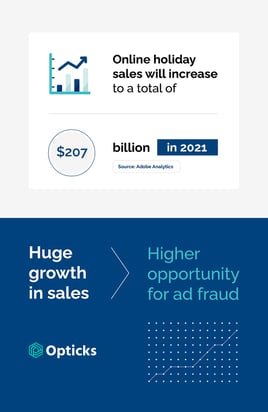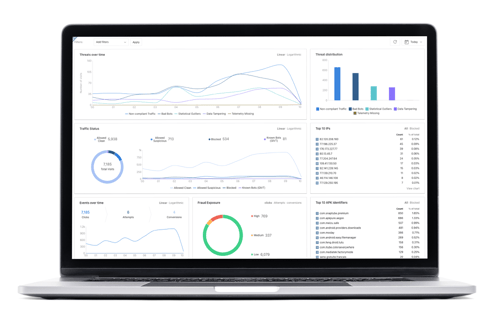How to Combat Seasonal Ad Fraud During the Holiday Season

 By
Eduardo Aznar
·
3 minute read
By
Eduardo Aznar
·
3 minute read
From Cyber Monday to Black Friday, Super Saturday to Singles’ Day and Diwali, the fourth quarter of the year is always the busiest period for both consumers and marketers alike.
But what should be a season of good tidings for marketers, is also one of worry about rampant seasonal ad fraud. Higher traffic coupled with higher ad spend translates into more opportunities for seasonal ad fraud to occur, and with the colossal surge in online shopping, the threat is higher than ever.
Here, we explain the impacts of ad fraud during the holiday season, and what to do to protect your marketing efforts from seasonal scammers.
The real impact of ad fraud during the holiday season

One of the most difficult challenges of tackling seasonal ad fraud is pinpointing exactly how it impacts business operations. While the most obvious danger of seasonal ad fraud is wasted ad spend, there are many other ways it impacts your business. Let’s take a look at some of the most important consequences of seasonal ad fraud.
Wasted ad spend
Fraudsters capture a substantial share of marketers’ budgets that would otherwise be spent on real users.
One example of this occurs when marketers see a significant amount of clicks on their ad but very few conversions due to activities such as fraudulent redirects or click spamming, or the rise in the cost of conversion as a result of fraudulent ads with little results to show for it.
According to Opticks’ proprietary data, exposure to fraud during the fourth quarter of the year is 17 percentual points higher than during the rest of the year. With more spend on the table, the higher the absolute presence of fraud is. Plus, fraudsters aren’t choosy when it comes to who to scam. All industries and verticals are vulnerable to their mischievous tactics.
Missed targets
Many marketers are simply unaware of how seriously seasonal ad fraud impacts their targets, and in turn, their revenue.
The main reason you invest in ads is to have them convert. But, if you’re spending money on fraudulent activity that won’t convert, you are losing sales. According to Juniper Research, digital advertisers and agencies lost $42 billion to ad fraud in 2019.
All of this results in the mismanagement of resources and efforts, which ultimately leads to missed leads and sales targets the business has set.
Biased analytics
In an age where so much data is available to marketers, it’s common to assume that decision-making is easier than ever before. However, ad fraud ruins the purity of campaign data: false events skew analytics, and this means that marketers don’t know for sure what’s working and what isn’t, and how to make decisions that impact profitability.
Campaign statistics become negatively skewed due to actions like pixel stuffing, whereby marketers will see high levels of impressions but likely few click-throughs. This will persuade marketers that something in the ad is inadequate, often leading marketers to rethink their campaigns as a whole, when in fact, they might have well been on point all along.
Diminished ROI
Although ad campaigns usually have a relatively short shelf-life, seasonal campaigns have an ever shorter one, with even larger potential opportunities for growth.
Ad fraud shatters ROI growth. The combination of wasted ad spend, missed targets and skewed analytics results in reduced ROI.
COVID-19 becomes a catalyst for seasonal ad fraud

The global COVID-19 pandemic has changed purchasing behaviors and accelerated a further shift in e-commerce spending. Online holiday sales in the fourth quarter of 2021 are set to break all previous online spending records, with software giant Adobe predicting that online holiday sales will total $207 billion. This shift presents even more opportunities for ad fraud to occur.
How to tackle ad fraud during the holiday season
As the presence of ad fraud ticks upwards this holiday season, marketers need to protect their ad campaigns. Here are some of the most important steps to take in the run-up to the holiday season.
Rely on trusted partners and channels
Since advertisers demand strong results during this period, marketers are pressured to source a huge amount of traffic in a short amount of time, which exposes you to the threat of potential ad fraud.
To combat seasonal ad fraud, however, it’s necessary to thoroughly evaluate your partners to make sure they can reliably serve your ad campaigns. Ensure that any potential partner or channel actively blocks fraudulent clicks before fraudulent activity has been paid for, and always ask about their strategy for dealing with ad fraud. If they don’t have a robust strategy, it’s simple: don’t use them.
Don’t be tempted by cheap deals
Be wary of cheap ad traffic deals. Often these “too-good-to-be-true” deals correspond with prevalent ad fraud. Don’t sell out your ad budget for cheap tricks that often backfire.
Utilize an anti-fraud solution

Manual analysis and monitoring of your ad campaigns’ success is time-consuming and costly. Anti-fraud solutions stop ad fraud before it has a chance to impair your campaigns by blocking and tracking ad fraud in real-time.
Anti-fraud tools also help to address technological vulnerabilities that many firms are simply incapable of overcoming, often due to smaller budgets.
However, anti-fraud solutions should not only detect fraud, but accurately identify, assess, block, and track all fraudulent activity to help you sustain a proactive anti-fraud strategy, rather than a reactive one.
Proactive prevention: Your best chance of confronting seasonal ad fraud
Fraudsters continue to siphon huge amounts of money from advertising budgets throughout the year, and without proactive fraud prevention, seasonal ad fraud runs even more rampant.
As fraudsters also continue to revise and improve their tactics, modern anti-fraud solutions, such as Opticks, are the only type of solutions that can effectively protect your campaigns.
To receive a consultation on how the expert team at Opticks can help protect your advertising campaigns, contact our team here.
